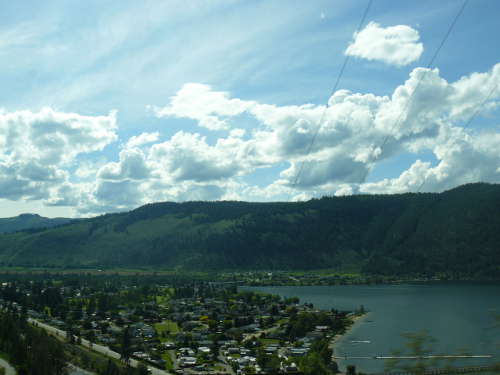 Location Taken: Chase, British Columbia
Location Taken: Chase, British Columbia
Time Taken: June 2010
It’s surprisingly difficult to pinpoint the spot where the trees fade away. There’s a bunch of them, at various points where the climate transitions from just wet enough for trees to just dry enough to not be able to support them well.
In most cases I’ve encountered, human activity obscures the line. The transition from the great forests of the eastern US to the plains of the middle of the continent are a great example. The line keeps getting pushed further and further east by large fields of crops, and it takes a while to realize there just aren’t that many trees in the margins anymore.
In the mountains, it’s a bit more obvious. There’s this effect called rain shadow that causes moisture to pile up on the windward side of a mountain and never make it across to the other side. There are plenty of places where you climb a mountain range and go from very tall trees on one side to dry scrub on the other. Snoqualmie Pass on I-90 heading east out of Seattle is a great example of just that.
Even then, though, there’s a transition section that obscures the line. The top of the pass is solidly an alpine climate, with trees that are short due to cool temperatures rather than moisture. This manages to create a gradual shift to both of the disparate climates on each side.
And then there’s cases like this, where you’re entering a rain shadow from the other direction. The land is mountainous enough that human activity hasn’t obscured everything. And there isn’t a special climate getting in between to obscure things.
Instead, the trees just start fading out. It starts on the steepest slopes, places where water runs past the quickest. Large meadows open up, the grass still vibrantly green. There’s enough moisture there for all but the largest plants, after all. And as you head deeper into the rain shadow, trees become limited to just the ridges and valleys, and then just to the banks of streams. The plants transition to the deep green grasses to the browner ones of desert climates. It does not take too long for the world around your car to look quite different than it was just a little further east.
And yet, even as clear as this particular case is, I doubt you spotted the fact that this mountain is heavily forested on the right side of the photo and lightly forested on the left until I pointed it out. There’s too many other distractions for the eye, the town spread out below the road, the dynamic clouds above it, the power lines cutting across the image. And well, you can’t deny that it’s a very natural transition, in all the meanings of that word.
